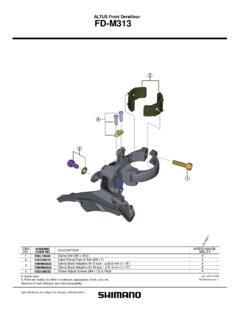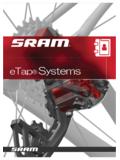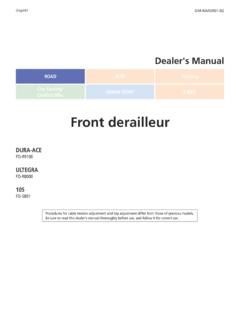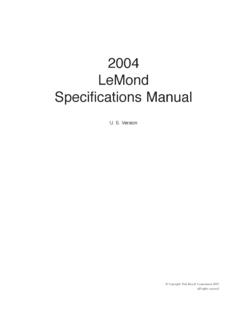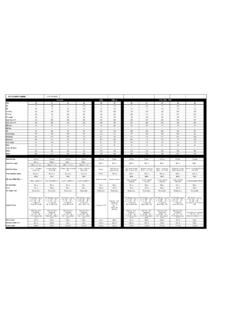Transcription of Main Street Pedi-cab Owner’s Manual
1 Main Street Pedi-cab Owner s Manual Table of Contents: I. Pedicab Frame A. Brakes 1. Rear hydraulic brakes 2. front rim brakes B. Gears and Shifters 1. Shifters and Derailleurs 2. Transfer hub 3. Chains C. Wheels D. Axle/Differential E. Electric Motor System II. Electrical lighting system A. Loose bulbs B. Checking wiring harness connections C. Fixing a shorted-out lighting system III. Pedicab cab A. Repairing fiberglass B. Rivet Replacement * Note: The added stress to your fork will warrant that you check it before each ride for cracks. The fork should be replaced at least once a season. If you carry more than two people in your pedicab at any time, we recommend that you upgrade to a stronger triple fork.
2 The electric assist system also puts added stress on your fork, and we recommend that you upgrade to a triple clamp heavy-duty front fork. Always use 1 1/8-inch chromoly mountain bike forks made for 26-inch wheels. Main Street Pedicabs sells both types of replacement forks at prices below the cost they can be obtained in most bicycle shops. Buying replacement forks directly from MSP insures that you are always getting a suitable fork. Not following these instructions may result in a catastrophic failure of your fork! Section I: Pedicab Frame A. Brakes 1. Rear Hydraulic Brake Bleeding Instructions Note: filling and bleeding of the brake system is not routine maintenance. This procedure is needed only when there is a loss of fluid (a leak in the system) or a line that has been damaged or recently removed.
3 Only DOT 5 silicon brake fluid should be used in the system Tools and Supplies needed: 2mm allen key 5mm allen key straight wrench At least 2 fl. Oz. DOT 5 brake fluid 30 cc Syringe with clear plastic tubing 1 new compression washer Barb fitting with clear plastic tubing Small bottle to catch drained brake fluid In order to bleed or fill the system with fluid or to repair a broken line, follow these steps: 1. The service kit contains everything you will need to bleed the brake system. This procedure must be done with the pedicab with all three wheels on level ground or with the rear wheels jacked up only a few inches off the ground. A service kit can be ordered from Main Street Pedi-Cabs. 2. Install a barbed fitting into a 6-inch segment of clear plastic tube by hand.
4 Remove the 5mm set screw at the master cylinder lever (throw away the old compression washer, as this is no longer useful), then tighten on the barbed fitting with clear vent tube. Put the tube into the small bottle in order to catch the fluid when it is forced through. This bottle will need to be temporarily attached to the handlebar. 3. The master cylinder lever must be turned horizontal on the handlebar so that the bleed screw is at the highest position of the brake system. Next, the small 2mm allen adjustment bolt (located directly behind the lever look in at the lever from the end of the handlebar) on the master cylinder must be fully loosened until it stops. 4. DO NOT squeeze the brake lever at anytime during this procedure. First, fill the syringe with DOT 5 brake fluid and clear it of all air bubbles.
5 Attach the clear plastic tubing on the syringe to the bleeder valve on the rear active brake caliper (the bleeder valve is a 1/4" brass screw), then loosen the 1/4" brass bleed screw at the caliper one full turn. Now force the fluid with the syringe through the system until fluid can be seen through the vent tube at the master cylinder lever. Air bubbles may be seen at the vent tube when filling. The bleeding is complete when there are no more air bubbles in the vent tube. At this point, tighten the 1/4" brass bleed screw. This procedure may need to be repeated two times to insure there is no air in the system. Note: if the procedure is repeated, the 1/4"brass bleeder screw must be tightened before the syringe is removed. 5. Now remove the vent tube with the barb fitting from the master cylinder lever and replace the 5mm allen set screw, with a new compression washer behind it.
6 These washers compress when you tighten them down, to seal off the fluid in the system. They can only be tightened down once, and then a new washer must be used. The system is correctly bled when the brake pads move immediately upon movement of the brake lever. If this does not happen, the system must be bled again. 6. Once all connections have been tightened, the master cylinder lever can be adjusted to provide a better brake feel by the 2mm adjustment screw that is directly behind the lever. Make sure not to tighten the adjustment screw too much as this will cause the brake pads to drag the disc. 7. Wipe down all surfaces with a rag and check the entire system for leaks and operation after bleeding the system. 8. The placement of the axle and brake disc within the brake calipers can also affect brake performance.
7 The best place for the brake disc to be is as close to inactive caliper (on the right side of the bike) as possible, without rubbing. By doing this, the fine adjustment on the master cylinder can close the gap on the active caliper side of the brake disc to allow for the smallest distance between the pads and the disc, and therefore the best braking power. Large adjustments of the brake disc placement can be made by loosening both wheels and loosening the locking collars on the 4 bearings with a 3mm allen key. Once the collars are loose, knock the axle to the correct place with a mallet and tighten everything back down. Fine adjustments to brake disc placement can be made by over tightening the axle nuts on the outside of the rear wheels.
8 2. Adjusting front Rim Brakes The front brakes may need to be adjusted to account for cable stretching, brake pad wear and replacement, or if the brakes become weak or misaligned for any other reason. Note: The primary braking power for the pedicab and the weight it carries is intended to come from the rear hydraulic brakes. Using only the front brake to stop a large load can result in fork, frame, or wheel damage. 1. The small peg on the back side of the brake calipers is placed into the proper hole on the fork, where the brake pad has the right amount of tension, so that it is able to reach the rim, but will still spring back away from it if released. The tension on both sides of the brakes need to equalize each other, so it is likely that you will need to choose the same hole for both calipers.
9 The factory setting is in the middle hole. Tighten down bolts that hold calipers onto fork with a #5 allen key. 2. The spacers that hold the brake pad onto the caliper go onto the brake pad bolt in this order (inside to outside of bike): brake pad, thin concave spacer, convex spacer, caliper, convex spacer, thick concave spacer, thin washer, #5 allen nut. The concave/convex sides fit together and the flat sides go against the caliper, brake pad, or thin washer, to allow the brake pad to be fully adjustable. The larger concave spacer has been placed on the outside of the caliper because pedicabs use wider rims than traditional bicycles. 3. Adjust the placement of the brake pad using a #5 allen key. With the wheel centered in the fork, push the caliper in against the rim while simultaneously loosening the allen nut on the brake pad bolt.
10 Try to get the brake pad flush with the rim and have the brake pad bolt perpendicular to the rim, to get the most efficient braking power. Repeat this step for the opposite side. 4. Pull the cable through the tops of the calipers and set the cable tension with the #5 allen bolt on the top of the left caliper. Hold the calipers together while tightening down the allen bolt. Check the tension in the brake handle you want the handle to pull tight before it hits the handlebar. Make finer adjustments as needed. 5. Adjust the left/right alignment of the calipers. When you squeeze the brake handle, does one side stop first or not move at all? Moving the peg behind the caliper, which was discussed in #1, can make very large adjustments. Smaller adjustments can be made one of two ways, or both.
